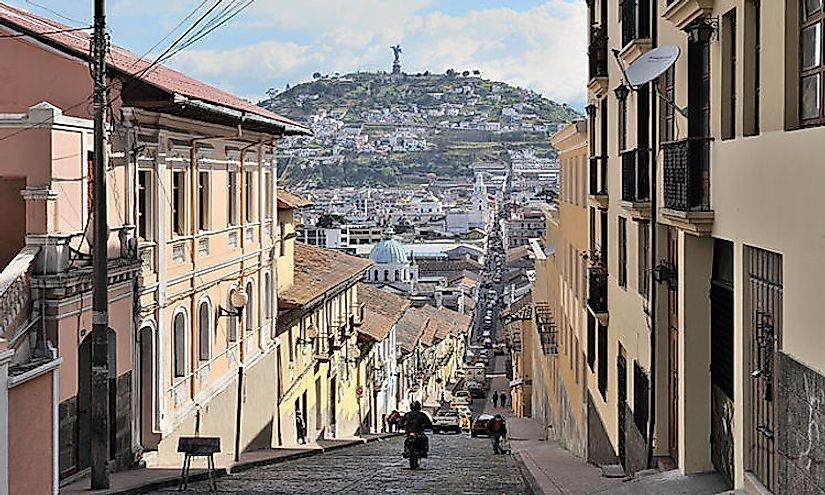UNESCO World Heritage Sites In Ecuador

Ecuador is a vast country to the west of South America bordering Colombia and Peru. It has four regions with diverse species of flora and fauna. Most of its flora lives under the government's protected areas like national parks and reserves. UNESCO declared some of its parks and reserves with spectacular biodiversity as natural World Heritage Sites. Together with these are other cultural World Heritage Sites like the city of Quinto that showcase the country's exquisite pre-historic culture and traditions.
UNESCO World Heritage Sites In Ecuador
Galapagos Islands
Located in the Pacific Ocean, almost 1,000 km from the coast of Ecuador, The Galapagos Islands is one of the richest marine ecosystems globally, formed through the ongoing seismic and volcanic activities that led to the development of unusual plants and animal life. They comprise of a total of 127 islands, islets, and rocks surrounded by the Galapagos marine reserve created in 1968 and extended in 1998, making it one of the largest marine reserves in the world. The reserve is home to a diverse underwater wildlife ranging from corals to sharks to penguins and marine animals that are so similar to human beings and can accompany divers. Its sea floor continues to evolve with the youngest islands being Isabela and Fernandina islands. Its three tectonic plates-Nazca, Cocos and Pacific plates meet at the Ocean base providing a site for great geological interest. The evolution process influences not only the geological structure of the island but its flora and fauna which display the adaptive radiations that still continue to date. Endemic fauna of the land are the giant tortoise, northerly species of penguins, flightless cormorants and the historical Darwin's finches and the native flora including 500 vascular plant species are significant tourist attractions in the islands. Main threats to this island are the introduction of invasive species, tourism pressure, demographic growth, illegal fishing, and poor governance. Legislation on controlled fishing and protection under the Galapagos national park, are efforts put in place to conserve the islands. The Galapagos Islands was named natural UNESCO world heritage site in 1978.
Qhapaq Nan Andean Road System
The road system is an extensive Inca communication defense and trade network of roads and structures of more than 30,000 km, based on four main routes originating from Cuzco and connecting to the several other small roads. It emerged as a result of the Inca community trying to link the trade and worship centers under one economic, social and cultural program of the empire. It exhibits the Andean's excellent engineering skills in road technology, based on the integration of the Andean knowledge and cultures to form a state organizational system that enabled the exchange of political, social, and economic values, and on their community values and principles of reciprocity, redistribution, and duality. It is a testimony to the Inca civilization. The structures still retain their characteristic features and design as constructed earlier on. Materials used are stone and earth varying from region to region. The network covers a total of six countries and thus the countries came together to form a management framework for the protection and preservation of the cultural road network. In 2014, UNESCO named it cultural world heritage site.
Quito Historic City
Established by the Spanish in 1534, the city was built on the ruins of the Inca city. It displays an integration of the native and the European artistic traditions typical of the Baroque school of art. Marked by the various spiritual citadels, like San Francisco, La Merced, San Augustin and San Domingo, the city bears not only artistic values but awesome decorations as well. It depicts the juxtaposition of the Inca's creativity with the architectural prowess of their colonial masters to produce unique and highly transcendental work, well adapted to their complex topographical environment. The historic buildings are well conserved, and any new buildings are built outside the colonial center. The historic city was named cultural world heritage site in 1978.
Sangay National Park
Located in the provinces of Chimborazo, Tungurahua, and Morongo Santiago, the Sangay National Park displays a variety of ecosystems ranging from tropical forests to glaciers, to two active volcanoes and the indigenous species of flora and fauna. There are more than 3000 species of plant life such as the alpine, wet forests and montane zones which provide food to the broad variety of fauna like the Andean fox, mountain tapir, giant otter, ocelot, brocket deer pudu among other unusual species. The over 450 bird species in the park include the giant hummingbird, little WordStar, condor, king vulture and the red-faced parrot among other. UNESCO declared it a natural heritage site in 1983. In 1992, the Sangay National Park was in danger because of the major road construction and poaching.
Conservation Of The World Heritage Sites
These world heritage sites, together with the famous Santa Ana de Los Rios de Cuenca historic center, are major sites that the government of Ecuador's boasts about in its endeavor to protect and preserve its nature, culture, and history which leads to sustainable tourism. The country is among the 17 most diverse countries in the world, and its biological, cultural, and geographic diversity is unparalleled. Through such practice as the best management practice program, Ecuador conserves its wildlife, environment and protects its culture.
UNESCO World Heritage Sites In Ecuador
| UNESCO World Heritage Sites in Ecuador | Year of Inscription; Type |
| Galápagos Islands | 1978; Natural |
| Qhapaq Ñan Andean Road System | 2014; Cultural |
| Quito Historic City | 1978; Cultural |
| Sangay National Park | 1983; Natural |
| Santa Ana de los Ríos de Cuenca Historic Center | 1999; Cultural |







